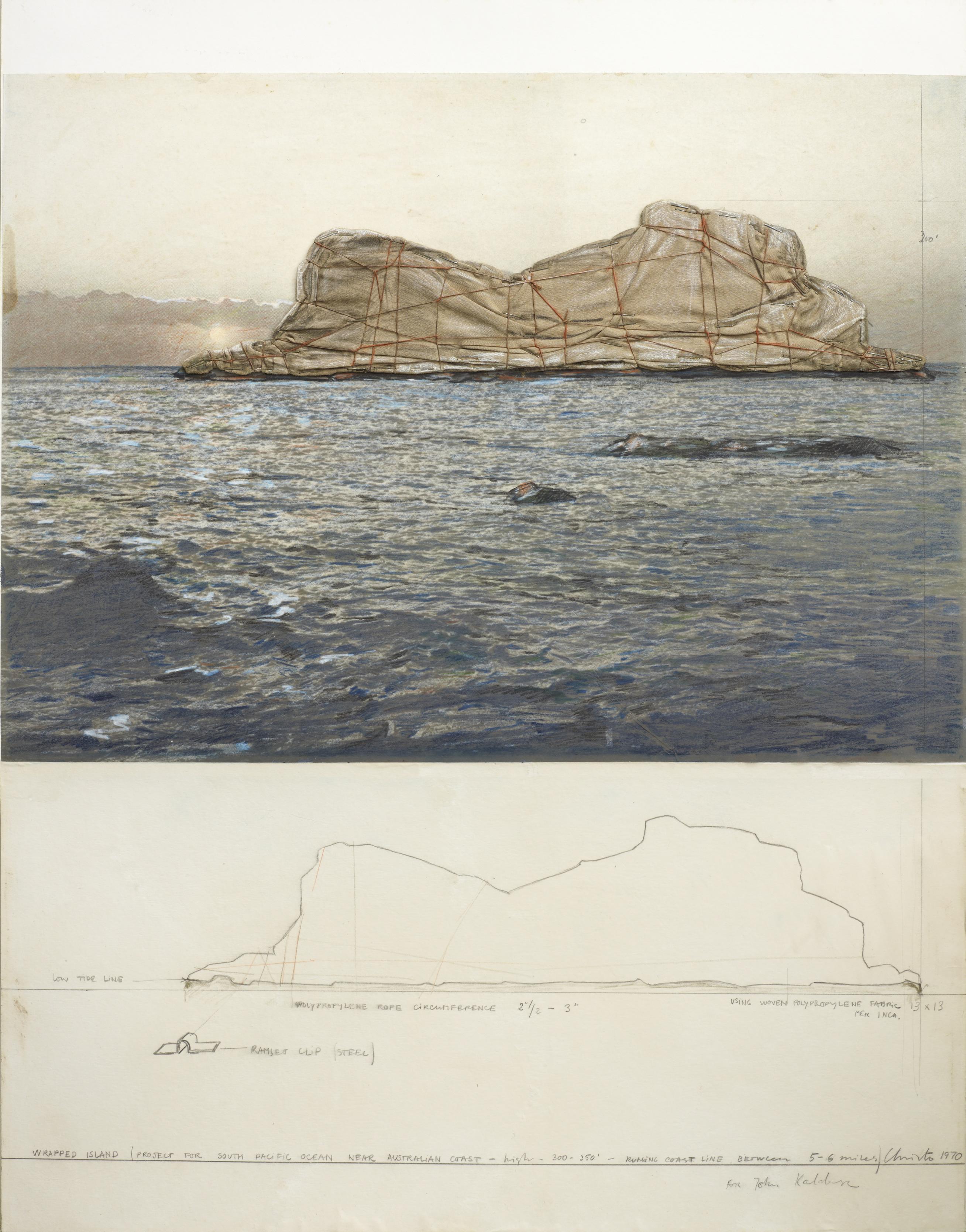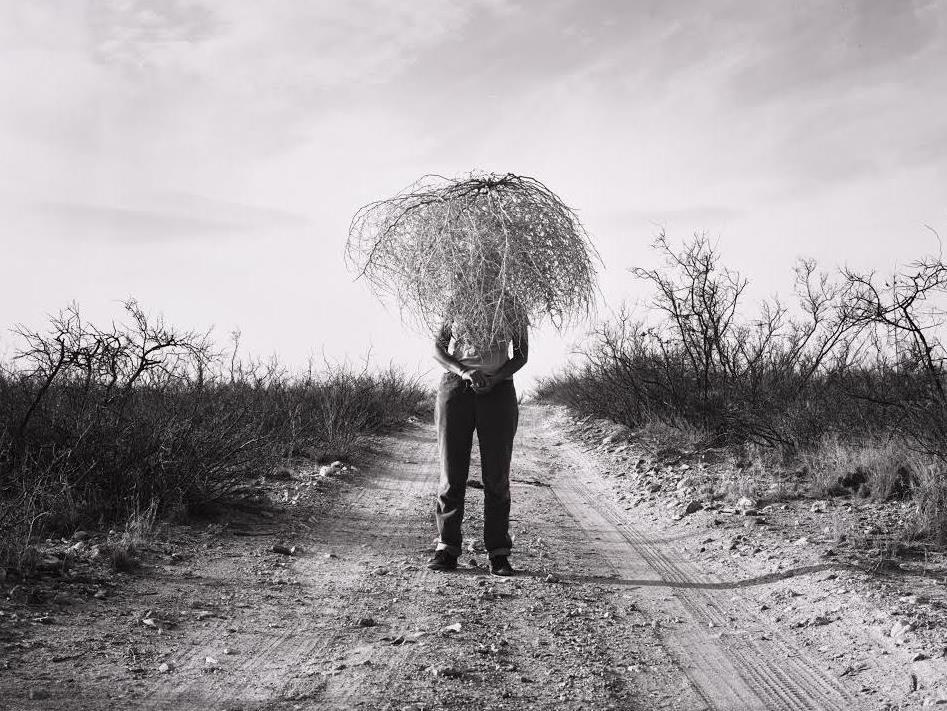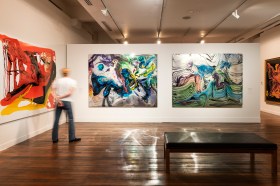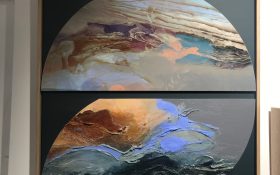Image: Christo (Bulgaria; United States of America, b.1935), Wrapped Island, Project for South Pacific Ocean 1970 collage: pencil, fabric, twine, staples, photograph, crayon, charcoal, pastel, Perspex box, 71.5 x 56 cm Art Gallery of New South Wales, John Kaldor Family Collection. Photo: Jenni Carter/AGNSW © Christo
The environment has always inspired artists but for contemporary artists living with an awareness of its fragility as well as its vastness, the landscape has become a newly pertinent theme.
British sculptor Richard Long walks the land, creating ephemeral works on his journeys through the wildness. Catalan artist Perejaume reflects on the hopeless task of trying to frame the landscape with gigantic frames. Bulgarian artist Christo and his wife Jeanne-Claude wrap or divide man-made spaces to draw our attention to the mass and volume of architecture.
Visit the Blue Mountains City Art Gallery
Work by each of these international artists will join pieces by key Australian artists such as Imant Tillers and Simryn Gill, in Landmarks, an exhibition exploring contemporary art of the land and environment at the Blue Mountains City Art Gallery opening 21 January next year.
Internationally renowned Blue Mountains’ artists Claire Healy and Sean Cordeiro, have created a large scale interactive installation that references a ‘lagerphone’ – also known as the ‘ugly stick’, ‘Mendozer’, ‘Money Money Money stick’ or ‘Murrumbidgee River Rattler’. Commonly associated with bush bands and gold rush era Australia, the lagerphone is festooned with crown cork bottle tops. These bottle tops were only invented in 1892 yet it is posited that early lagerphones were based upon Aboriginal instruments that utilised seashells rather than bottle tops to create the rattle. Visually representing issues of human engagement with the land from Indigenous history to early European settlement, the largerphone can be seen as a meeting between the native Australian environment (the stick) and imported Western culture (the bottle caps).
Landmarks explores the shifting perception of landscape that occurred in the late 20th century and saw artists’ work move from that of framing an image to a more immersive experience, where deeper observations and ideas about relationship with the land were investigated – thus marking the emergence of land art.

Image: Simryn Gill (Singapore; Malaysia; Australia, b.1959), from Vegetation 1999, 5 gelatin silver photographs, each 124 x 129.5 cm. Art Gallery of New South Wales. Gift of the artist 2005. Photo: Jenni Carter/ AGNSW. © Simryn Gill
‘In this exhibition we show how conceptual artists have sought to give us a sense of what it is like being in the landscape without necessarily representing its visual appearance,’ explains curator Anthony Bond, OAM.
‘Each artist brings to their work their own interpretation and relationship with the natural world and through Landmarks we see the convergence of these varied and diverse insights.’
Combining works by local Blue Mountains artists with works from global artists and significant pieces from the John Kaldor Family and Australian art collections at the Art Gallery of New South Wales, the exhibition explores the relationship between artist and landscape on both an international and local scale, and challenges the perception of the natural world whilst resonating with the evocative terrain of the Blue Mountains.
‘Partnering with the Art Gallery of New South Wales is a remarkable opportunity,’ said Paul Brinkman, Director of the Blue Mountains Cultural Centre. ‘Landmarks represents a unique and important exhibition for the Blue Mountains City Art Gallery which, now celebrating its five-year anniversary, is becoming recognised as a preeminent regional arts venue.’
‘It is also a great example of how regional galleries can collaborate with major art institutions and their collections to innovatively reinterpret works and present them in a new context,’ he explained.
The partnership has allowed the Blue Mountains City Art Gallery to access work from the John Kaldor Family Collection at the Art Gallery of New South Wales. The Collection of 204 works includes pieces by Jeff Koons, Robert Rauschenberg and Carl Andre. The donation of John Kaldor Family Collection was the largest single art donation to an Australian public gallery.
The Blue Mountains City Art Gallery is part of the Blue Mountains Cultural Centre in Katoomba, an artistic hub which showcases innovative and diverse cultural programs. The Gallery features major touring, curated, regional and local exhibitions, including a program dedicated to showcasing locally residing artists. The Gallery also hosts curator and artist talks, educational workshops, concerts, gallery tours and outreach programs to the community.
Following the exhibition at the Blue Mountains City Art Gallery, Landmarks, will tour to Tamworth Regional Gallery and Murray Art Museum Albury (MAMA) throughout 2017.





